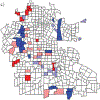Neighbourhood alcohol availability and gonorrhea rates: impact of social capital
- PMID: 19440966
- PMCID: PMC6167931
- DOI: 10.4081/gh.2009.224
Neighbourhood alcohol availability and gonorrhea rates: impact of social capital
Abstract
Social capital and income inequality have been proposed as important mediators of the relation between the material environment and health outcomes. We determined whether indicators of social capital are (i) associated with neighbourhood gonorrhea rates, and (ii) mediate the relation between alcohol outlet density and gonorrhea rate. Longitudinal analyses of age- and sex-adjusted gonorrhea cases reported from 1990 to 1996 in the 445 census tracts affected by the 1992 civil unrest in Los Angeles, California was conducted. The role of alcohol outlets was assessed both as tracts with surrendered off-sale outlets due to the civil unrest and annual off-sale alcohol outlet density rates. Tract level voting rates were used as one indicator of social capital, while neighbourhood structure conducive to social organization was used as another. Neighbourhoods with greater voting over time and greater endogenous social organization experienced 1.9 and 67.2 fewer gonorrhea cases per 100,000. Results also reveal a partial mediating role of social capital on the relationship between alcohol outlet density and gonorrhea rate. The alcohol environment may have a direct or partially mediated role in infectious disease outcomes such as gonorrhea. Our findings support the importance of continuing controls and limits on off-premise alcohol outlet density, as a potential means of reducing gonorrhea rates and increasing social capital.
Figures





Similar articles
-
Determinants of social capital indicators at the neighborhood level: a longitudinal analysis of loss of off-sale alcohol outlets and voting.J Stud Alcohol Drugs. 2007 Nov;68(6):934-43. doi: 10.15288/jsad.2007.68.934. J Stud Alcohol Drugs. 2007. PMID: 17960312
-
Alcohol outlets, gonorrhea, and the Los Angeles civil unrest: a longitudinal analysis.Soc Sci Med. 2006 Jun;62(12):3062-71. doi: 10.1016/j.socscimed.2005.11.060. Epub 2006 Jan 19. Soc Sci Med. 2006. PMID: 16423436 Free PMC article.
-
A geographic relation between alcohol availability and gonorrhea rates.Sex Transm Dis. 1998 Nov;25(10):544-8. doi: 10.1097/00007435-199811000-00009. Sex Transm Dis. 1998. PMID: 9858351
-
Social capital and the neighborhood alcohol environment.Health Place. 2009 Mar;15(1):323-32. doi: 10.1016/j.healthplace.2008.06.001. Epub 2008 Jun 26. Health Place. 2009. PMID: 18672392 Free PMC article.
-
Alcohol availability and neighborhood characteristics in Los Angeles, California and southern Louisiana.J Urban Health. 2008 Mar;85(2):191-205. doi: 10.1007/s11524-008-9255-1. Epub 2008 Jan 29. J Urban Health. 2008. PMID: 18228148 Free PMC article.
Cited by
-
How Do Social Capital and HIV/AIDS Outcomes Geographically Cluster and Which Sociocontextual Mechanisms Predict Differences Across Clusters?J Acquir Immune Defic Syndr. 2017 Sep 1;76(1):13-22. doi: 10.1097/QAI.0000000000001463. J Acquir Immune Defic Syndr. 2017. PMID: 28797017 Free PMC article.
-
Venue-based recruitment of women at elevated risk for HIV: an HIV Prevention Trials Network study.J Womens Health (Larchmt). 2014 Jun;23(6):541-51. doi: 10.1089/jwh.2013.4654. Epub 2014 Apr 17. J Womens Health (Larchmt). 2014. PMID: 24742266 Free PMC article.
-
Changing Places and Partners: Associations of Neighborhood Conditions With Sexual Network Turnover Among African American Adults Relocated From Public Housing.Arch Sex Behav. 2017 May;46(4):925-936. doi: 10.1007/s10508-015-0687-x. Epub 2016 Feb 29. Arch Sex Behav. 2017. PMID: 26927277 Free PMC article.
-
Associations between county-level voter turnout, county-level felony voter disenfranchisement, and sexually transmitted infections among women in the Southern United States.Ann Epidemiol. 2019 Jan;29:67-73.e1. doi: 10.1016/j.annepidem.2018.10.006. Epub 2018 Oct 29. Ann Epidemiol. 2019. PMID: 30442564 Free PMC article.
-
People and places: Relocating to neighborhoods with better economic and social conditions is associated with less risky drug/alcohol network characteristics among African American adults in Atlanta, GA.Drug Alcohol Depend. 2016 Mar 1;160:30-41. doi: 10.1016/j.drugalcdep.2015.11.036. Epub 2015 Dec 10. Drug Alcohol Depend. 2016. PMID: 26781062 Free PMC article.
References
-
- Anselin L, 2005. Exploring spatial data with GeoDa: a workbook. Urbana, IL, Santa Barbara, CA: Center for Spatially Integrated Social Science. Spatial Analysis Laboratory, University of Illinois, Usa.
-
- Bourdieu P, 1986. The forms of capital In: The Handbook of Theory: Research for the Sociology of Education. Richardson JG (Ed), Greenwood Press, New York, USA, pp. 241–258.
-
- Bursik RJ, 1988. Social disorganization and theories of crime and delinquency: problems and prospects. Criminology 26, 519–551.
-
- Campbell C, Williams B, Gilgen D, 2002. Is social capital a useful conceptual tool for exploring community level influences on HIV infection? An exploratory case study from South Africa. AIDS Care 14, 41–54. - PubMed
Publication types
MeSH terms
Grants and funding
LinkOut - more resources
Full Text Sources
Medical
